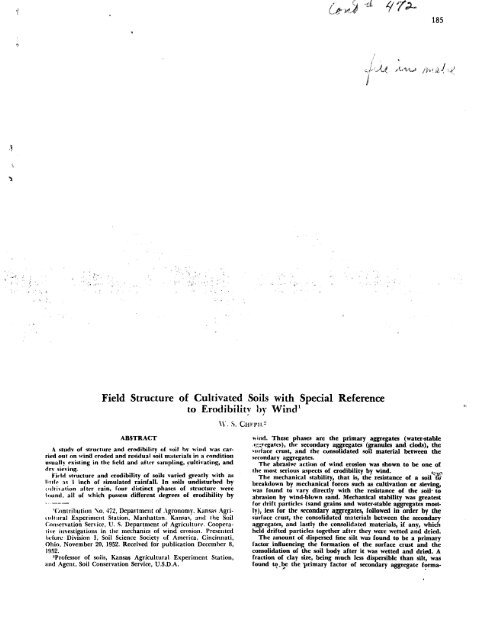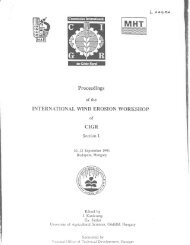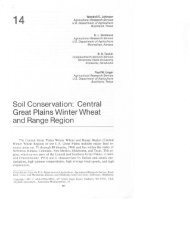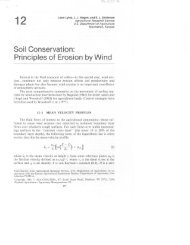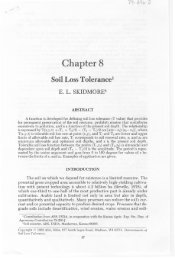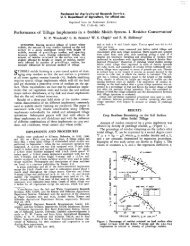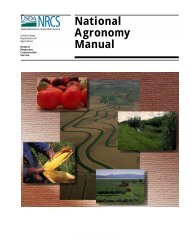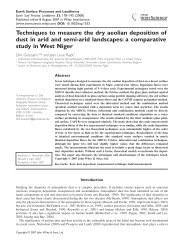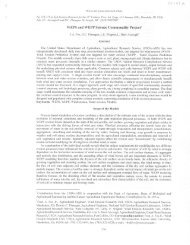Field Structure of Cultivated Soils with Special Reference to ...
Field Structure of Cultivated Soils with Special Reference to ...
Field Structure of Cultivated Soils with Special Reference to ...
You also want an ePaper? Increase the reach of your titles
YUMPU automatically turns print PDFs into web optimized ePapers that Google loves.
<strong>Field</strong> <strong>Structure</strong> <strong>of</strong> <strong>Cultivated</strong> <strong>Soils</strong> <strong>with</strong> <strong>Special</strong> <strong>Reference</strong><strong>to</strong> Erodibilitv by Wind'ABSTRACTA studv <strong>of</strong> ~nrtc~re and erodibility nf wit hv wind was carriednut on croded and residual soil materials in a conditiont~sunllv existing in the field and alwr san~pling, qdtivating, anddry sieving.Fkld structure and erodibility <strong>of</strong> soils varied greatly <strong>with</strong> asIictlc ns I inch <strong>of</strong> simdated rainfall. In soils undisturbed byc illti\ a tion af ter rain, fowr distinct phases <strong>of</strong> structure wereIound, all <strong>of</strong> which possess different degrees <strong>of</strong> erodibility by'Conlrihution 30. 472, Department <strong>of</strong> .\gmiomy. liansa? Agric~alr~cralExperinlcnt Station. Manhattan. Kansas, mcl the SoilC:onrcrvation Service, I!. S. Departnwnt <strong>of</strong> Agricrrlturt.. Cooprraliveinvestigarions in the mechanics <strong>of</strong> wind erosion. PresentedIwlore Division I, Soil Scienre Society <strong>of</strong> America, Cincinnati,Ohio, November 20, 1952. Received for publication Decemher 8,1952.aPr<strong>of</strong>essor <strong>of</strong> soils, Kansas Agricultnral Experiment Station,and Agent, Soil Conservation Service, U.S.D.A.wand. These phases are the primary aggregates (water-stable~!::;~egatn), the secondary aggregate? (granules and clods), thewrface crust, and the consolidated soil material between thesecondary aggregates.The abrasiw artkm <strong>of</strong> wind erosion was shown <strong>to</strong> be one <strong>of</strong>the moat serious aspects <strong>of</strong> erodibility by wind.The mechanical stability, that is, the resistance <strong>of</strong> a soil'Qwt~breakdown by mechanical forces such as cultivation or sieving,was found <strong>to</strong> vary directly <strong>with</strong> the resistance <strong>of</strong> the soil. <strong>to</strong>abrasion by wind-blown sand. Mechanical stability was greatestfor clrif t particle* (sand *grains and water-stable aggregates mostly),less fur the secondary aggregates, followed in order by thesurface crust, the consolidated materials between the secondaryaggregates, and lastly the consolidaterI materials, if any, whichheld drifted particles <strong>to</strong>gether after they were wetted and dried.The amount <strong>of</strong> dispersed fine silt was found <strong>to</strong> be a primaryfac<strong>to</strong>r influencing the formation <strong>of</strong> the surface crust and theconsolidation <strong>of</strong> the soil body after it was wetted and dried. AEraction <strong>of</strong> clay size, being much less dispersible than silt, wasfound tq.? the primary fac<strong>to</strong>r <strong>of</strong> secondary aggregate forma-
186 SOIL SCIENCE SOCIETY PROCEEDINGS 1953tion. Waterdispersible silt and clay were responsible in largemeasure for the resistance <strong>of</strong> the soil <strong>to</strong> erosion by wind. Althoughthe amount <strong>of</strong> erosion was limited <strong>to</strong> some degree bythe presence ,<strong>of</strong> waterrtable aggregates <strong>to</strong>o large <strong>to</strong> be movedby wind, it was found that cultivated dryland soils lack theseaggregates in sficient amounts. The resistance <strong>of</strong> these soils <strong>to</strong>wind action was found <strong>to</strong> depend primarily on their ability t<strong>of</strong>orm secondary aggregates, or clods.The secondary aggregates prese~ed their identity below thesurface even after repeated wetting and drying in the field. Itwas concluded, therefore, that the physical condition <strong>of</strong> the soilis indicated as well or better by methods such as dry sieving,which primarily measure the state <strong>of</strong> the secondary aggregates,than by methods that measure the state <strong>of</strong> the primary aggregates.RESHLY cultivated soils are composed <strong>of</strong> a more orFless loose mixture <strong>of</strong> particles and aggregates <strong>of</strong>widely variable dimensions. These may range fromlarge clods several inches in diameter <strong>to</strong> particles <strong>of</strong>dust. Erodibility in such a condition is dependent primarilyon the proportion and bulk density <strong>of</strong> erodiblefractions contained in the soil when it is dry (3). Onlydry soil materials are eroded by wind.An entirely different regimen <strong>of</strong> conditions exists ina cultivated soil after it has been wetted by rain anddried. A surface crust is almost invariably formed due<strong>to</strong> impacts <strong>of</strong> raindrops on the ground. Often the crustis hardly discernible but has a pr<strong>of</strong>ound influence onerodibility. Except at fhe immediate surface, the primary(water-stable) aggregates and the secondary aggregates,including clods, usually undergo little transformationby individual aet,ting from rain and drying. *A $-eater change occurs in' the degree <strong>of</strong> compactnessand cementation between the various Ytc~gnizable ag- ,gregates. This type <strong>of</strong> cementation has an importantinfluence on erodibility by wind, but the degree <strong>of</strong>cementation is generalli tdo weak <strong>to</strong> be detecgble bywet or dry sieving. Thus, wet or dry aggregate analysesbased conventionally on sieving or elutriation in wateror air omit entirely some important aspects <strong>of</strong> soilstructure. A study was conducted <strong>to</strong> gain more specificinformation <strong>of</strong> the various phases <strong>of</strong> soil structure common<strong>to</strong> cultivated soils in the field and how thesephases relate <strong>to</strong> erodibility by wind.,ProcedureComposite samples <strong>of</strong> soil when in a dry condition were taker.from 1 <strong>to</strong> 2 inches <strong>of</strong> depth from wind-eroded fields and fromfreshly accumulated drifts <strong>with</strong>in or near the eroded fields. Fourfields were chosen, all from the black soil zone, representingLancaster sandy loam, Crete silt loam, Rokeby silty clay loam,and Sutphen clay. Henceforth, the soil will be referred <strong>to</strong> bytextural class only.Samples from the freshly accumulated drifts, still unaffectedby rain, represented that portion <strong>of</strong> the soil which had beenmoved about by the wind and deposited against obstructions ortraps, such as weeds, fence rows, or road ditches. Henceforth forconvenience, soil material obtained from there drifts will be refmd<strong>to</strong> as drifted soil material and soil material obtained fromihe wind-eroded fields as residual soil material.Determinations were made <strong>of</strong> the physical soil characteristicswhkh might have had some bearing on erodibility by wind.These determinations included mechanical composition by themethod <strong>of</strong> Bouyoucos (I), the size-frequency distribution <strong>of</strong> waterstableparticles and aggregates by the method <strong>of</strong> Yoder (9) modifiedin accordance <strong>with</strong> the latest Soil Conservation Servicerecommendations, the size-frequency distribution <strong>of</strong> dry aggregatesand their mechanical stability by the rotary sieve method(4), and the amounts <strong>of</strong> erosion determined in the labora<strong>to</strong>rywind tunnel used regularly in this work.Td measure the amount <strong>of</strong> erosion the soil was placed in aporous-bot<strong>to</strong>m tray 5 feet long, 8 inches wide, 2 inches high,and e?posed <strong>to</strong> wind until soil movement cease'd. The, wind hada drag velocity <strong>of</strong> about 1.4 miles peE hour and a velocity <strong>of</strong> about25 miles per hour at a 6-inch height. The amounts <strong>of</strong> erosionfrom trays placed parallel <strong>with</strong> the direction <strong>of</strong> the wind weredetermined under three sets <strong>of</strong> conditions: (a) exposing wellmixeddry soils <strong>to</strong> wind; (b) exposing <strong>to</strong> wind after consolidatingthe soil by spraying <strong>with</strong> 1 inch <strong>of</strong> water and drying, and (c)exposing <strong>to</strong> wind and <strong>to</strong> sand abrasion after consolidating thesoil. Fine dune sand was used as abrader and was placed in atray immediately on the windward <strong>of</strong> the tray that containedthe soil.The surface crusts, caused by spraying, were tested for abradabilityby dune sand and also for resistance against breakdownby sieving. The crusts were scraped <strong>of</strong>f gently <strong>with</strong> a spatulawhen the soil was dry and sieved on the rotary sieve.Another series <strong>of</strong> tests was conducted <strong>to</strong> determine more convenientlythe abradability <strong>of</strong> the different structural units <strong>of</strong>the soil. In these tests small volumes <strong>of</strong> clods 1/, <strong>to</strong> 1/, inch indiameter and cylindrical blocks <strong>of</strong> soil were exposed <strong>to</strong> abrasionby dune sand. The clods or blocks <strong>of</strong> soil were placed on theleeward <strong>of</strong> the tray containing the abrader. The clods wereplaced <strong>to</strong> cover the bot<strong>to</strong>m <strong>of</strong> a trough sloping in<strong>to</strong> the direction<strong>of</strong> the wind. The vertical moss-sectional area <strong>of</strong> that surface <strong>of</strong>the clods exposed <strong>to</strong> abrasion by dune sand was the same as that<strong>of</strong> the cylindrical block <strong>of</strong> soil. The amount <strong>of</strong> abrasion wasdetermined by weighing the clods or block <strong>of</strong> soil before andafter exposure and adding <strong>to</strong> this difference the weight <strong>of</strong> thesoil fragments greater than 0.42 mm that were broken <strong>of</strong>f theclod or block and lodged at the foot <strong>of</strong> it. The amount <strong>of</strong> thesoil fragments greater than 0.42 mm was determined by sieving.Consolidation <strong>of</strong> soil blocks, which were 2 inches in diameterand 2 inches high, was accomplished by placing a soil in a waxedpaper cylinder <strong>with</strong> open <strong>to</strong>p and bot<strong>to</strong>m and spraying the <strong>to</strong>p<strong>of</strong> the soil <strong>with</strong> about 1 inch <strong>of</strong> water, followed by drying.Wetting and drying was repeated several times in some cases.In every, case the4consoJidated soil, even when composed <strong>of</strong> almostpure sand, held <strong>to</strong>gqtber <strong>with</strong>out crumbling.Finally, the degree pf,disporsion <strong>of</strong> the various fractions <strong>of</strong>',the soil in water was determined. Air dry soil was imdrsed ins'water in .a vacuum and the bbttIesL containing the soil. and thewater were turned end over end at the rate <strong>of</strong> 30 turns perminute for 2 minutes. The percentage <strong>of</strong>Tpar\icles smaller than0.02 mm contained in suspension was hetermined by the hydrometermethod.ResultsSIZE AND NATURE OF SOIL FRACTIONSTRANSPORTED BY WINDDry soil fractions transported by wind and depositedin drifts in the vicinity <strong>of</strong> the eroded fields were generallysmaller than 0.84 mm in diameter (table 1). Afew fractions exceeding this diameter were mainly organicfragments, considerably lighter than the mineralparticles or aggregates.It will also be seen from table 1 that soil marerialsdeposited in the drifts contained much less dust smallerthan 0.05 mm in diameter than corresponding soilmaterials from the eroded fields. Evidently much <strong>of</strong>this fine fraction was carried away from the vicinity<strong>of</strong> the eroded fields and only a portion <strong>of</strong> it was depositedin the drifts.Although the residual soil materials coritained somewater-stable aggregates <strong>to</strong>o coarse <strong>to</strong> be moved bywind, the amount <strong>of</strong> these in the soils studied wasrelatively small. A great percentage <strong>of</strong> the water-stableaggregates was <strong>of</strong> a size readily erodible by wind(table 1).The erodibility <strong>of</strong> well-mixed, freshly cultivatedsoils (condition (a), table 1) varied <strong>with</strong> the amount <strong>of</strong>erodible fraction contained in the soil. In sandy loamand silt loam the erodible fraction was predominantlysmaller than 0.42 mm in diameter, but in the finertextured soils a considerable proportion <strong>of</strong> particlesfrom 0.42 <strong>to</strong> 0.84 mm in diameter also constituted anerodible fraction (table 1). Clay had the highest pro-
CHEPIL: FIELD STRUCTURE OF SOILS AND WIND EROSION 187r_SoilclassSoilmaterialTable 1.-Physical properties <strong>of</strong> wind-eroded (drifted) and residual soil materials.Dry fractionsWater-stable fractionsI I Amounts eroded*ISandyloamSiltloamSilty clayloamClayDriftedResidualDriftedResidualDriftedResidualDriftedResidual*Conditions described in "Procedure."portion <strong>of</strong> erodible fractions ranging from 0.42 <strong>to</strong> 0.84mm in diameter, and these fractions apparently contributedgreatly <strong>to</strong> the high erodibility (9.5 <strong>to</strong>ns peracre).IINFLUENCE OF SOIL CONSOLIDATION AND OFABRASION ON ERODIBILITY BY WINDThe application <strong>of</strong> 1 inch <strong>of</strong> water sprayed on the soil followedby drying (condition b, table 1) produced a surface crdstand a cementation <strong>of</strong> the soil body which greatly reduced the :erodibility by wind. The crust was easily recognizable by its ,dense,"platy structure. This type <strong>of</strong> structure became less distinct<strong>with</strong> depth till it merged <strong>with</strong> the mass <strong>of</strong> soil below at a depth .varying <strong>to</strong> % in&, de$ending on the soil. The most tenaciouscrust and the greatest degree <strong>of</strong> cementation below the crust wason silt loam and silty cl&y loam. A thin, fragile crust was formedon sandy loam and a thicker but even more fragile one on clay.Comequently, the greatest propprtional reduction in erodibilitydue <strong>to</strong> soil consolidation was qn silt loam and silty clay loam,less on sqpdy loam, and least on clay.The amount <strong>of</strong> erosion increased greatly when a stream <strong>of</strong>dune sand was blown over the consol~dated soils in a dry state(condition c, table 1). The cutting, grinding, and impact action<strong>of</strong> sand disintegrated the surface crust and some <strong>of</strong> the consolidatedmaterial below the crust in<strong>to</strong> particles small enough<strong>to</strong> be moved by wind. This type <strong>of</strong> structural disintegration isknown as abrasion and is a very important phase <strong>of</strong> the winderosion process on all soils (3). There are two main aspects <strong>of</strong>abrasion: One is the disintegration <strong>of</strong> nonerodible or consolidatedsoil units in<strong>to</strong> particles small enough <strong>to</strong> be moved bywind, and the other is the wearing-away <strong>of</strong> erodible soil unitsin<strong>to</strong> dust capable <strong>of</strong> being carried away from the vicinity <strong>of</strong> theeroded region, Methods <strong>of</strong> measurement described herein aredesigned primarily <strong>to</strong> measure the former aspect which, fromthe standpoint <strong>of</strong> wind erosion control, is perhaps a more importantaspect <strong>of</strong> the abrasion process.On the whole, the consolidated sandy loam was most subject<strong>to</strong> abrasion. Clay had a very fragile crust which wore <strong>of</strong>f readilyunder abrasion, but dry clay aggrega'tes were extremely resistant<strong>to</strong> abrasion. Silt ham and silty clay loam had a surface crust mostresistant <strong>to</strong> abrasion, yet their aggregates showed a moderatedegree <strong>of</strong> resistance <strong>to</strong> abrasion.It was evident from these preliminary tests that the differentphases <strong>of</strong> sail structure in a dry state possess different degrees<strong>of</strong> abradability. A study was continued <strong>to</strong> find possible relationshipsbetween the physical properties <strong>of</strong> the different structuralunits <strong>of</strong> the soil and their abradability.MECHANICAL STABILITY AND ABRADABILITY OFDIFFERENT STRUCTURAL UNITS OF WIND-ERODED AND RESIDUAL SOILSA separation d some structural units <strong>of</strong> the soil bysieving in a dry state was necessary <strong>to</strong> study more convenientlythe abradability <strong>of</strong> these different units. All<strong>of</strong> the structural units broke down somewhat undersieving, but in various degrees. The rotary sieve wasused for this purpose.The breakdown <strong>of</strong> clods and other structural units<strong>of</strong> the soil bv sieving varied directlv <strong>with</strong> the abradability<strong>of</strong> th&e fraccons (figure 1). '~hus, the looselyconsolidated blocks <strong>of</strong> wind-eroded particles obtainedfrom fresh drifts were most subiect <strong>to</strong> breakdown bvsieving and also <strong>to</strong> breakdown dy abrasion <strong>with</strong> dunksand. Blocks <strong>of</strong> the same sieve-fraction from residual.., soils were less,subject <strong>to</strong> breakdown by sieving and'alsoby abrasion <strong>with</strong> dune sand. Pry clods were much lesssubject <strong>to</strong>L breakdokn by. sipving and also much less~ubject '<strong>to</strong> disintegration Ijy abrasion in<strong>to</strong> particlessmall enough <strong>to</strong> be moved by wind.The resistance <strong>of</strong>t the soil <strong>to</strong> breakdown by mechanicalforces, such as sieving or abrasioil by drifting sand,is known as mechafiical stabilitv. The mechanical stabilityis a fklative measure <strong>of</strong> cdherence or strength <strong>of</strong>cementation ,between or <strong>with</strong>in the particles or soilaggregates in a dry state and, as used in this study, isw1equal <strong>to</strong> 100 -, where W is the weight <strong>of</strong> individuaIWparticles or aggregates, or the weight <strong>of</strong> a consolidatedbody <strong>of</strong> these units before sieving and W1 is the weightafter the sieving. The speed <strong>of</strong> disintegration <strong>of</strong> theindividual particles or aggregates measures the stren~th --<strong>of</strong> cementation <strong>with</strong>in these units; the speed w~thwhich consolidated bodies disintegrate <strong>to</strong> individualstructural units is a measure <strong>of</strong> cementation betweenthese units.A study <strong>of</strong> the abradability <strong>of</strong> bodies or blocks <strong>of</strong>soil by wind-blown soil grains showed that the soilbody is composed <strong>of</strong> several different types <strong>of</strong> structuralunits'havi%g widely different degrees <strong>of</strong> mechanicalstability or coherence and, consequently, <strong>of</strong> Bisistance<strong>to</strong> abrasion by wind-blown soil grains. Soilgrains blown in<strong>to</strong> drifts by wind had the greatestmechanical stability and, therefore, were least susceptible<strong>to</strong> abrasion (table 2). As shown in table 1 thesegrains were, in the main, water-stable aggregates andindividual sand grains. Virtually complete resistance<strong>to</strong> breakdown by sieving was exhibited by wind-erodedsand grains common in sandy loam soil and by aggregatesfrom clay. A somewhat lower mechanical stabilitywas exhibited by wind-eroded units (mostly waterstableaggreggtes) from silt loam and silty clay loam.
SOIL SCIENCE SOCIETY PROCEEDINGS 1953a-Consolidoted frodlon t0.42f r residual ~ soils-8-Consolidated residual soilsGrams abraded ta 0.42 mm. from fresh*t s ....................Dry aggregates and clods >0.42mm .....................Surface crust M <strong>to</strong>inchthick; ...................Fraction
the size <strong>of</strong> silt and clay'were washed down, leavingsome coarser grains loose on the surface crust. Theseloose grains moved readif in saltation and causedIsome abrasion <strong>of</strong> the sur ace crust, the amount <strong>of</strong>abrasion depending on. the amount <strong>of</strong> the grqins, themechanical stability'<strong>of</strong> the surface crust, and the distancethat the grains moved along the ground. Even<strong>with</strong> a distance as short as 5 feet, it was evident fromcasual observation that the amount <strong>of</strong> abrasion <strong>of</strong> thesurface crust was much greater on the leeward thanthe windward end.Next in order <strong>of</strong> mechanical stability and resistance<strong>to</strong> abrasion was the consolidated material initially composed<strong>of</strong> fractions smaller than 0.42 mm in diameter(table 2). These fractions are highly erodible if unconsolidatedand are found in various amounts betweenthe coarser ranules and clods. The cementing forceor cohesion % etween these particles in a consolidatedstate, as for the surface crust, was least in clay andsandy loam and greatest in silt loam soil. Consolidatedbodies composed <strong>of</strong> these fractions disintegrated at arelatively high rate under impacts <strong>of</strong> abrasion by dunesand, 1 gram <strong>of</strong> the abrader wearing away from 0.6 <strong>to</strong>1.5 grams <strong>of</strong> the consolidated material, depending onsoil texture (figure 1). Thus, the rate <strong>of</strong> abrasion <strong>of</strong>these consolidated bodies was 150 <strong>to</strong> 300 times as greatas that <strong>of</strong> granules and .clods.Blocks <strong>of</strong> consolidated soil composed <strong>of</strong> all structuralunits common in cuIt\vated soils abraded veryunevenly (figure 3). After ri ihort"duration <strong>of</strong> exposure .the granules and clods began? <strong>to</strong> protrude in<strong>to</strong> the airstream indicating that after wetting they were merelyembedded in the fine, loosely consolidated portion <strong>of</strong>the soil. The strength <strong>of</strong> cementation between the aggregateswas much lower than that <strong>with</strong>in these aggregates,hence the reason why consolidated blocks <strong>of</strong> soilabraded so unevenly.Last in order <strong>of</strong> mechanical stability and therefore<strong>of</strong> resistance <strong>to</strong> abrasion were the consolidated bodiescomposed <strong>of</strong> particles less than 0.42 mm in diameterdrifted and deposited in<strong>to</strong> dunes by wind (figure 1and table 2). The rate <strong>of</strong> abrasion <strong>of</strong> these consolidatedbodies was from about 300 <strong>to</strong> 1,000 times as great as<strong>of</strong> granules and clods. It is evident that the cementingmaterial capable <strong>of</strong> holding these particles <strong>to</strong>getherafter consohdatjon, thereby resisting erosion by wind,was partly removed in the form <strong>of</strong> dust < 0.05 mm indiameter (table 1). The data in table 1 show also thatthere was a considerable removal <strong>of</strong> water-stable fractions< 0.02 mm from the soil material drifted anddeposited in<strong>to</strong> dunes by wind. It is apparent that theseparticles were the cause <strong>of</strong> strong cementation foundbetween the secondary aggregates or clods.To determine the influence <strong>of</strong> these fine waterstablefractions on soil structure, soils were immersedand shaken in water for 2 minutes and the particlessmaller than 0.05 mm in diameter were removed byrepeated decantation after appropriate periods <strong>of</strong> settling.The water-stable grains or aggregates greaterthan 0.05 mm were then dried. There was virtually nocementation between the water-stable aggregates afterblocks <strong>of</strong> these were wetted and dried. The water-stableaggregates from all soils acted much like sand grainsin that they failed <strong>to</strong> cohere <strong>to</strong> each other. It is apparentthat the finely dispersed fraction <strong>of</strong> the soil is<strong>to</strong> some degree responsible for holding these water-CHEPIL: FIELD STRUCTURE OF SOILS AND WIND EROSIONstable fractions <strong>to</strong>gether <strong>to</strong> form secondary aggregatesor clods.Discussion and ConclusionsThe study indicates that the great majority <strong>of</strong> thewater-stable aggregates contained in Chernozem soilsare <strong>of</strong> the size readily eroded by wind. Since the waterstableparticles or aggregates represent the more stablestructural units <strong>to</strong> which the soil may be disintegratedin the field, it may be expected that the increase intheir size will increase the resistance <strong>of</strong> the soil <strong>to</strong> winderosion. The problem is how <strong>to</strong> create enough <strong>of</strong> thewater-stable aggregates sufficiently large <strong>to</strong> resist thewind.The resistance <strong>of</strong> these soils <strong>to</strong> wind erosion is dependentconsequently on their ability <strong>to</strong> form whatmay be considered as secondary aggregates, that is,coarse granules and clods. In fact, emergency methods<strong>of</strong> wind erosion control are based principally on methods<strong>of</strong> tillage that leave the soil surface rough andcloddv. ,The formation <strong>of</strong> secondary aggregates is shownfrom this study <strong>to</strong> be due in large measure <strong>to</strong> theamount <strong>of</strong> water-dispersible cements. Tillage, pressureat depth, repeated wetting and drying, and time prob- :ably all influence the dispersion <strong>of</strong> soil cements andcontribute <strong>to</strong>'the formation <strong>of</strong> secondary aggregates orclods. Since many soils undergo frequent wettings inthe field it has beead assumed that a useful measure <strong>of</strong>soil aggregation would be found by sieving the soil in:- water rather than in the air (a).+ The secondary aggre- s' - gates or clods were thus considered as a transient massthat slakes <strong>with</strong> repeated wetting and drying. Thisstudy shows, however, that a clod, the same as anyother structural aggregate, is "transient," but only indegree. Individual rains are shown <strong>to</strong> have little influenceon the form or compactness <strong>of</strong> clods below thesurface. The identity <strong>of</strong> these secondary aggregates ismore or less preserved even after repeated wetting anddrying in the field. Therefore, the field structure <strong>of</strong>soil is indicated as well or better by methods, such asdry sieving, which primarily measure the state <strong>of</strong> thesecondary aggregates, than by methods that measurethe state <strong>of</strong> the primary aggregates. Only <strong>with</strong>in a narrowzone <strong>of</strong> the immediate surface do the secondaryaggregates become appreciably disintegrated by impacts<strong>of</strong> raindrops where the soil mass assumes a structuredifferent from that below.This study shows that the formation <strong>of</strong> secondaryaggregates is due primarily <strong>to</strong> the proportion <strong>of</strong> waterdispersiblesoil particles <strong>of</strong> the size <strong>of</strong> clay, perhaps <strong>of</strong>both mineral and organic origih, obtained when theaggregates ,are skaken in water. When this fraction <strong>to</strong>gether<strong>with</strong> dispersed silt is removed from the soil, thewater-stable aggregates <strong>of</strong> which the secondary ag&gates are composed remain loose much like individualsand grains. Russell (6) affirms that micro-aggregates(water-stable aggregates) " . .may be considered as uhitsfrom which clods in arable soils are built-up." Thisstudy shows that the micro-aggregates are virtuallyincapable <strong>of</strong> forming the secondary aggregates or clodsunless a certain proportion <strong>of</strong> cementing fraction <strong>of</strong>the size <strong>of</strong> clay is dispersed among these aggregates.The importance <strong>of</strong> secondary aggregates in, soilstructure forqation is not fully recognized in agriculturalresearch. For example, a recent review OK soil
aggregate formation (7) fails even <strong>to</strong> mention the secondaryaggregates, and the whole thesis <strong>of</strong> soil structureformation is based on the unfortunate assumptionthat the status <strong>of</strong> the water-stable aggregates as conventionallydetermined by sieving, elutriation, or sedimentationin water is a proper index <strong>of</strong> soil structure.However, soil structure as it exists in the field is acomplex condition. Consequently, no single methodcan be used <strong>to</strong> evaluate it completely.Primary and secondary aggregates are phases <strong>of</strong> soilstructure common under field conditions. There is yeta third phase that assumes major importance <strong>with</strong> respect<strong>to</strong> erodibility by wind and, no doubt, also <strong>with</strong>respect <strong>to</strong> soil tilth and probably <strong>to</strong> erodibility bywater. This third phase is concerned <strong>with</strong> cohesiveforces that are exerted between the secondary aggregatesafter the soil has been wetted and then dried.The degree <strong>of</strong> cementation between the secondary aggregatesvaries greatly, as <strong>with</strong>in the aggregates, dependingon the number and the nature <strong>of</strong> wettingand on the physical-chemical nature <strong>of</strong> the soil.The degree <strong>of</strong> cementation between the secondaryaggregates after the soil has been wetted and dried isdue in large measure <strong>to</strong> the amount <strong>of</strong> particles <strong>of</strong> thesize <strong>of</strong> silt and clay dispersed by the wetting. Dispersedsilt, although usually not considered as a soil cement,acts as a weak cement after the soil is wetted and dried.Silt disperses in water much more readily than particles<strong>of</strong> the size <strong>of</strong> clay. The presence <strong>of</strong> large amounts<strong>of</strong> dispersed silt particles in a soil appears <strong>to</strong> cause theformation <strong>of</strong> a compact, massive structure which, whilequite resistant <strong>to</strong> wind erosion, may present a seriousstructure problem otherwise. Bradfield and Jamison(2) conclude that hard and intractible soils are usuallythose largely composed <strong>of</strong> fine silt ,having a singlegrain structure when dispersed in water. Kaspirov (5)further concludes that the main fac<strong>to</strong>r in crust formationis the presence in soils <strong>of</strong> water-dispersible particlesless than 0.01 mm in diameter, regardless <strong>of</strong> theamount and quality <strong>of</strong> humus or the amount <strong>of</strong> saltspresent in soil solution. The present study confirmsthe above conclusions.It is generally recognized that soil possessing a welldevelopedwater-stable structure is much more resistant<strong>to</strong> water erosion than one <strong>with</strong> a poorly developedwater-stable structure (6). Resistance <strong>to</strong> watererosion is probably primarily determined by soil permeability.The determining fac<strong>to</strong>r <strong>of</strong> resistance <strong>of</strong> soil<strong>to</strong> wind erosion, on the other hand, is the size <strong>of</strong> dryaggregates large enough not <strong>to</strong> be moved by the wind.Many soils that have a well developed water-stablestructure are extremely erodible by wind because the-%t~ Surface crust 0 ~econdory aggregatePtimary aggregates:& :,., Consoll&red materidbrtwren secondaryogpegatesFIG. 4. -Diagrammatic representation <strong>of</strong> field structure <strong>of</strong> soil.size <strong>of</strong> the aggregates is, on the whole, <strong>to</strong>o small <strong>to</strong>resist the wind. Mineral soils resistant <strong>to</strong> wind erosiongenerally contain more than 60 per cent <strong>of</strong> dry aggregatesgreater than 0.84 mm in diameter as determinedby dry sieving, regardless <strong>of</strong> whether these aggregatesare stable in water or not.The fourth phase <strong>of</strong> field structure in cultivatedsoils is the surface crust, which results principally fromthe beating action <strong>of</strong> raindrops on the ground. Itcreates conditions <strong>of</strong> the soil surface, some <strong>of</strong> whichtend <strong>to</strong> reduce and some <strong>to</strong> increase: erodibility by I >, wind. The, beating action <strong>of</strong> raindrops consolidates~. some <strong>of</strong> the erodible soil fractions and tends <strong>to</strong> reduceerodibility. At the same,,timet it tends <strong>to</strong> smooth thesoil surface and this tends <strong>to</strong> increase the erodibility.The raindrop action also tends <strong>to</strong> leave some soilgrains or aggregates loose on the surface. These grainsare readily, poved in saltation and under certain conditionscause' considerable abrasion <strong>of</strong> the surfacecrust. The various phases <strong>of</strong> field structure in cultivatedsoils are shown diagrammatically in figure 4.Literature Cited1. Bouyoucos, G. J. Agron. Jour. 43:434 (1951).2. Bradfield, R., and Jamison, V. C. Soil Sci. Soc. Amer. Proc.(1937\ 3:70 (1938).3. ~he~il:~. S.'Soil ~ ci. 72:387 (1951).4. -. Soil Sci. Soc. Amer. Proc. (1951) 16:113 (1952).5. Kaspirov, A. I. 81. 1940.6. ~u&ell, E. W. Imp. Bur. Soil Sci., Tech. Comm. No. 37 (1938).7. Stallings, J. H. U.S.D.A.. Soil Cons. Service., SCS-TP-110,(1952). -8. Tiulin, A. F. Perm. Agric. Exp. Sta., Div. Agric. Chem., 2:77(1928).9. Yoder, R. E. Jour. Amer. Soc. Agron. 28:337 (1956).


